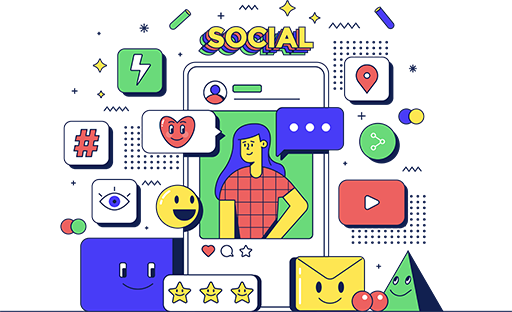What is a social media influencer?
A social media influencer is similar to a brand promoter. Through their content, social media influencers build rapport with their following, which makes them credible enough to then guide their followers’ purchases. A social media influencer also helps to highlight a brand’s message to a specific target audience.
With 58% of the world’s population now using social media, influencers have become a pivotal aspect of marketing. At the core of influencer marketing is simply talking about or sharing your interests as a person. As a result, followers with shared interests are likelier to listen when influencers promote brands or products. Social media influencers could promote fashion, food, movies, makeup, or anything in between. They could even be celebrities like the Portuguese soccer player Cristiano Ronaldo. As the most-followed person on Instagram, his 455 million followers have a vested interest in his life. In a nutshell, social media influencers generally retain a loyal following that trusts their endorsements.
What a social media influencer does
Have you ever bought something online based on a review? Most people have. That’s because reviews and recommendations stem from trust. In fact, almost 78% of people trust online reviews. Although social media influencers are not typically word-of-mouth marketers, their reviews and endorsements through their content carry weight with their followers. This also means they have to create and share enjoyable content. As well as endeavor to expand their community.
Content is also a large pool of references for an influencer. This could be anything from tutorials and how-tos to silent comedy mimes for entertainment. Khaby Lame is a social media influencer who creates TikTok videos of overcomplicated tasks with a straightforward approach. His content, composed mainly of silent mockery, recently earned him the title of most-followed TikToker and a multi-year deal with fashion giant Hugo Boss.

Social media content has to be top-quality and unique. It also has to stay relevant because users can easily swipe left or click unfollow if they lose interest. Having a focal point is also a must because if the content is random and sporadic, it’s much harder to build a sphere of influence. That’s why influencer marketing is based on focused content. This helps to engender trust and cement a connection to a specific target audience.
Four types of Social Media Influencers
A social media influencer is ranked by follower count, from entry-level to top-level users. Combine this with the number of posts, and you can determine an influencer’s engagement rate. In particular, this measures how much interaction an influencer has with their audience. The Engagement rate calculator from GRIN is a useful tool for brands to analyze the engagement level between an influencer and their followers. A solid engagement rate ranges between 1% and 5%.
Here are a few examples:
1. Nano Influencers' followers:
1000-10 000
Nano’s can have up to 7x the engagement of more prominent influencers even with a smaller audience because their audience is incredibly niche. They’re also a solid collaboration option for brands with a small business budget. Kara, a Seattle travel blogger and content creator, is an excellent example of a nano influencer. With 9400 followers and 740 posts, her engagement rate of 3.50% highlights her active involvement with followers.
2. Micro-Influencers' followers:
10 000-100 000
Micros’ have a more substantial engagement rate than influencers with a larger and more generic audience, leading to higher product purchases from followers. Ada Oguntodu is a fashion and style Micro influencer. She also organizes fundraisers to benefit charities like the Fashion Revolution Foundation. With a following of 64 900 and 3100 posts, her engagement rate is a steady 1.11%.
3. Macro Influencers' followers:
100 000-1 000 000
Macro Influencers fall into the category of minor celebrities such as well-known YouTubers or Bloggers. Although they work primarily with brands with a larger budget, they successfully increase brand awareness because of their recognizable names. Dennis Prescott, a Macro celebrity chef, is also a cookbook author and the host of Netflix’s show, Restaurants On The Edge. With a following of 615 000 and 3608 posts, his engagement rate is a fluid 1.01%.
4. Mega Influencers' followers:
1 000 000+
Mega’s have the most significant number of followers and mostly celebrities or well-known society names. Their brand endorsements usually have a massive budget. Shannon Harris is a beauty influencer from New Zealand, known for makeup and beauty tip tutorials. With a following of 1 300 000 and 6400 posts Shannon has a high engagement rate of 1.96%.
Why companies use social media influencers
A social media influencer knows what their audience wants, so it’s easier for companies to work with them to create content that solidifies their brand’s presence and reputation. In addition, once an influencer’s campaign goes viral, there’s the added benefit of attracting a different audience base, helping them to stand out from the crowd of competitors.
Companies use influencers because they:
- Have a large audience
- Increase online traffic
- Grow brand following
- Build trust in a brand
- Generate leads and sales
How do companies use social media influencers?
For instance, video-game influencer Ninja collaborated with Adidas to create the signature jogger, an exclusive sneaker that sold out within 40 minutes of going live.
Brands may even give social media influencers free rein with their products. For example, snack brand Takis teamed up with famous TikTok influencer Charli D’Amelio who uses her dance and lip-sync videos to endorse their product. Many of her Takis posts, including a movie night and life, is Fuego, have already received millions of likes.
Ultimately, influencer marketing is effective because influencers have a natural flow with their audience. Using content that resonates with the audience can also weave in aspects of their brand endorsement. Similar to learning how to get into voice acting, learning how to be an influencer takes time, research, and investment. Subsequently, companies worldwide are now focused on harnessing social media influencers’ power in marketing.
FAQ's
Find your niche and post regular, useful content to increase your engagement rate. Once your followers start growing, you can reach out to brands or other influencers to collaborate.
Yes, but to gain the attention of more prominent brands, you need to invest time and effort to increase your followers, engagement rate, and trustworthiness.
The most successful influencers keep their content authentic and entertaining. They also learn skills, research, and stay up-to-date with the latest trends.






















